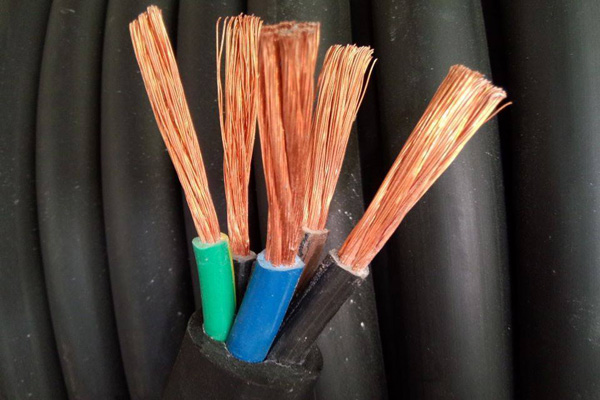Copper wire and Shanghai copper prices are experiencing a significant downward trend due to the evolving global markets and the continued pressure of multiple negative factors in overseas markets.
This phenomenon is triggered by the military conflict between Palestine and Israel, which has further exacerbated geopolitical risks in the region.
The Importance of Copper Wire
When it comes to copper, it is undoubtedly the backbone of the power cable industry. The use of copper in the cable industry has gone far beyond aluminum. When it comes to the importance of copper, the importance of cables has to be mentioned.
Most of the current wires and cables use copper as a conductor.
Copper has good electrical conductivity
Copper has a very high electrical conductivity that far exceeds that of other materials commonly used to make wires such as aluminum, steel, or iron.
This means that with the use of copper conductors in wires and cables. Current can flow more efficiently with less energy loss and power can be transmitted over longer distances.
Corrosion Resistance of Copper Cable
Corrosion resistance means that copper cables can be used in almost every environment.
Copper is also resistant to oxidation, corrosion, and embrittlement. This makes it an excellent material that can be used in a wide range of wire and cable applications in a variety of categories.
Copper is very soft and malleable
This means that it can be easily bent and formed, making it suitable for installation in cable ducts.
This softness makes copper a conductor material that is easy to work with and assemble.
Copper wire has high thermal conductivity
Wires and cables generate heat as they transmit current. And using copper conductors allows them to dissipate heat more quickly to keep operating temperatures stable.
Whether it is in the daily household cables or this global attention to the Palestinian-Israeli conflict, cables play a significant role and can not be ignored.
In the latest news, the Palestinian health sector said on the 17th, the Israeli army airstrike on a hospital located in the Gaza Strip on the same day. Most of the victims were patients, women, and children.
The Hamas side said that the death toll exceeded 500 people.

This is undoubtedly a heavy blow to Palestine. In addition to the direct deaths in the bombed hospitals. The death toll will continue to rise as a result of the water and electricity cuts caused by the bombing.
The power supply must be restored. In hospitals, the most commonly used electrical equipment is medium voltage and high voltage cables. These cables also need to be shielded, flame retardant, etc. when purchased. Currently, many national government agencies require the use of low-smoke halogen-free cables in hospitals, schools, shopping malls, and other public places. These cables do not emit toxic and harmful gases when burning and do not burn extensively in high-intensity fires.
Reasons for the Decline in Copper Wire Prices
First, the slowdown in global economic growth is one of the main factors.
Overseas markets are subject to multiple pressures such as trade friction, and monetary tightening. And geopolitical conflicts, resulting in a slowdown in global economic growth and weakening demand for non-ferrous metals.
In addition, market sentiment is also an important factor affecting copper prices.
Against the backdrop of continued bearish market sentiment, investors have chosen to sell copper futures contracts, further depressing copper prices.
However, in this storm, the demand for safe-haven products such as gold gradually increased.
To avoid risk, investors chose to put money into hedge products, resulting in gold and other precious metals prices continuing to rise.
What kind of impact does this behavior have on copper prices?
On the one hand, the price of hedge products attracts part of the capital flow. Reducing the investment demand for copper and other non-ferrous metals, and further promoting the decline in copper prices.
On the other hand, rising prices of safe-haven products also reflected the market’s concern about future economic uncertainty. Which put some pressure on the non-ferrous metals market.
ZMS also focused on the phenomenon of rising prices of industrial production materials.
Prices of industrial means of production have continued to rise due to factors such as tight global supply chains and fluctuating raw material prices.
What impact has this phenomenon had on non-ferrous metal companies?
Rising prices of industrial means of production have led to higher costs for companies, compressing the profit margins of non-ferrous metal companies.
This trend may also affect the investment decisions of enterprises, which in turn will have a long-term impact on the non-ferrous metals market.
In the current environment, however, copper cable prices are coming under greater pressure in today’s trading.
The reason?
Multiple negative factors in overseas markets continue to exert pressure, leading to reduced investor demand for copper futures contracts. The strength of much of the global end-consumption has not lived up to expectations, with downstream buyers remaining cautious and the uplift market failing to rebound.
Together, these factors contributed to the pressure on copper cable in today’s trading.

Summary of common types of copper wires
Power Cable Copper Wire
Power cables are cables made of copper conductors and insulating materials, mainly used to transmit electricity or signals.
According to the carrying voltage can be divided into high-voltage cables, medium-voltage cables, low-voltage cables, and ultra-high-voltage cables.
According to the outer covering material is divided into plastic cable, rubber cable, oil-immersed cable, and cross-linked cable.
Communication Cable
Communication cables are cables based on copper wires to transmit information, mainly used to transmit data and audio signals.
Divided into twisted pairs, coaxial cable, fiber optic cable, and so on. Among them, twisted-pair cables are divided into shielded twisted-pair cables and unshielded twisted-pair cables, which are widely used in various types of networks, telecommunications, broadcasting, and other industries.
Control Cables
Control cables are mainly used for industrial control, measurement, regulation, and other aspects, such as industrial automation, robotics, and so on.
The outer jacket is made of plastic, rubber, and other heat-resistant, oil-resistant, cold-resistant, and other special materials.
Commonly, there are oil-resistant, sterile, corrosion-resistant, and other insulated cables.
In summary, copper cables can be divided into three main categories: power cables, communication cables, and control cables.
Each category of cable also has different specifications, pipe diameter, outer skin, and other details.
When choosing specific copper cables, you also need to choose according to the specific use scenarios and needs.
When copper cable prices are subject to volatility, it is not only a concern for countries in conflict, but also a reminder for other countries in dire need of copper cables. Seizing every price opportunity is the right thing to do.
